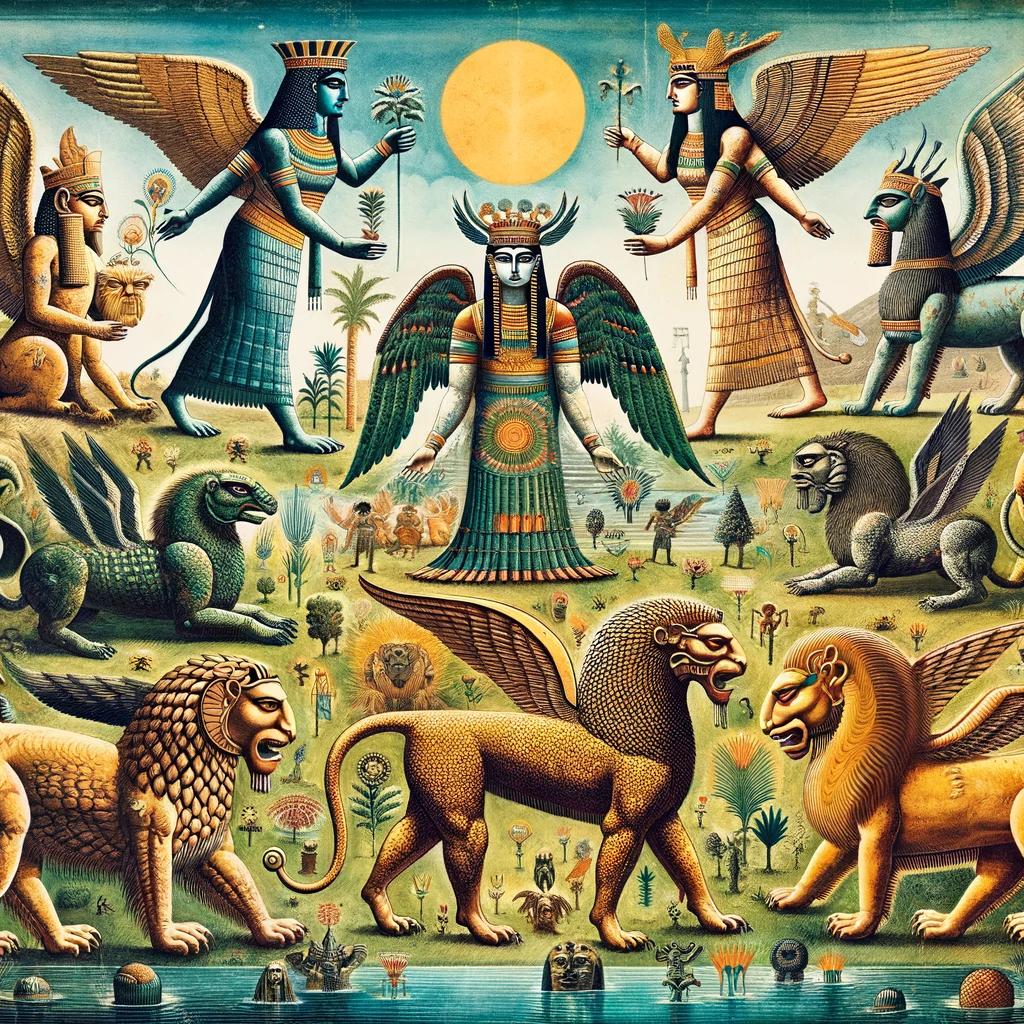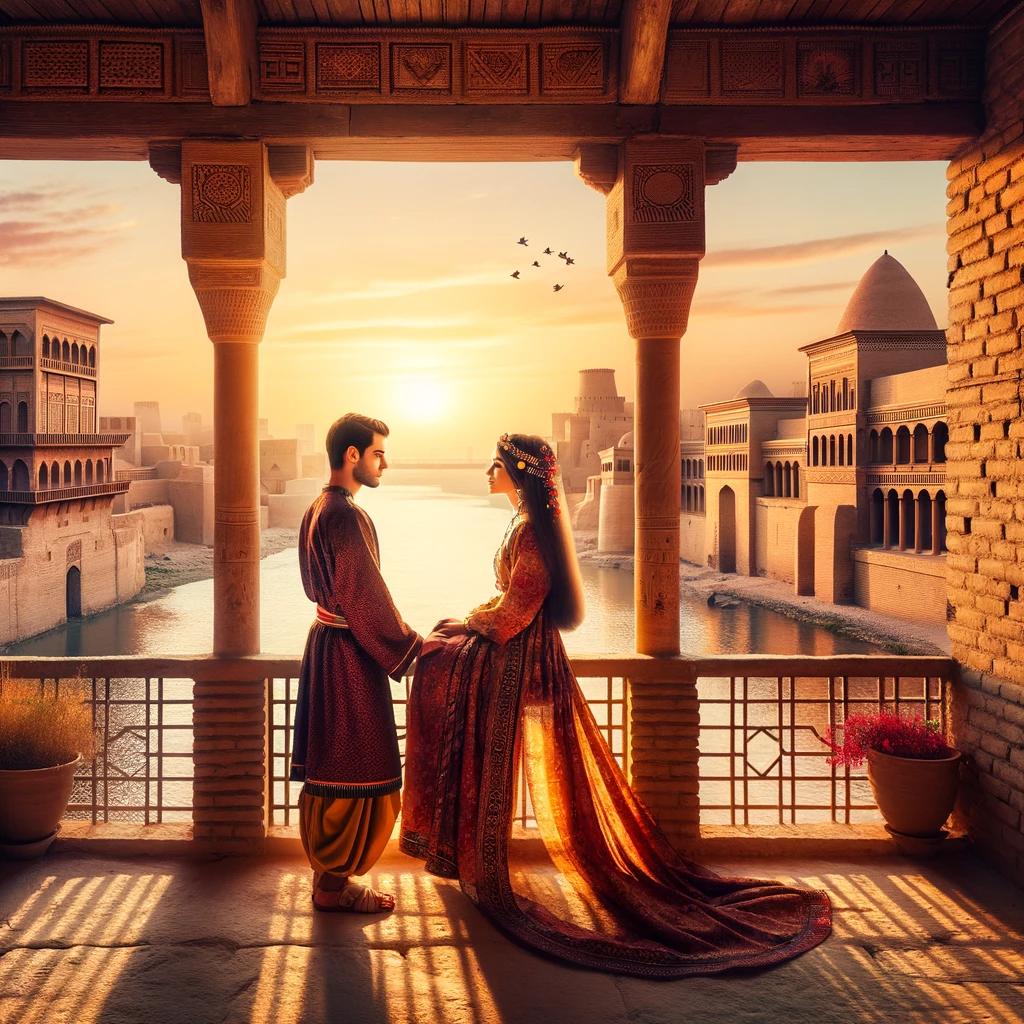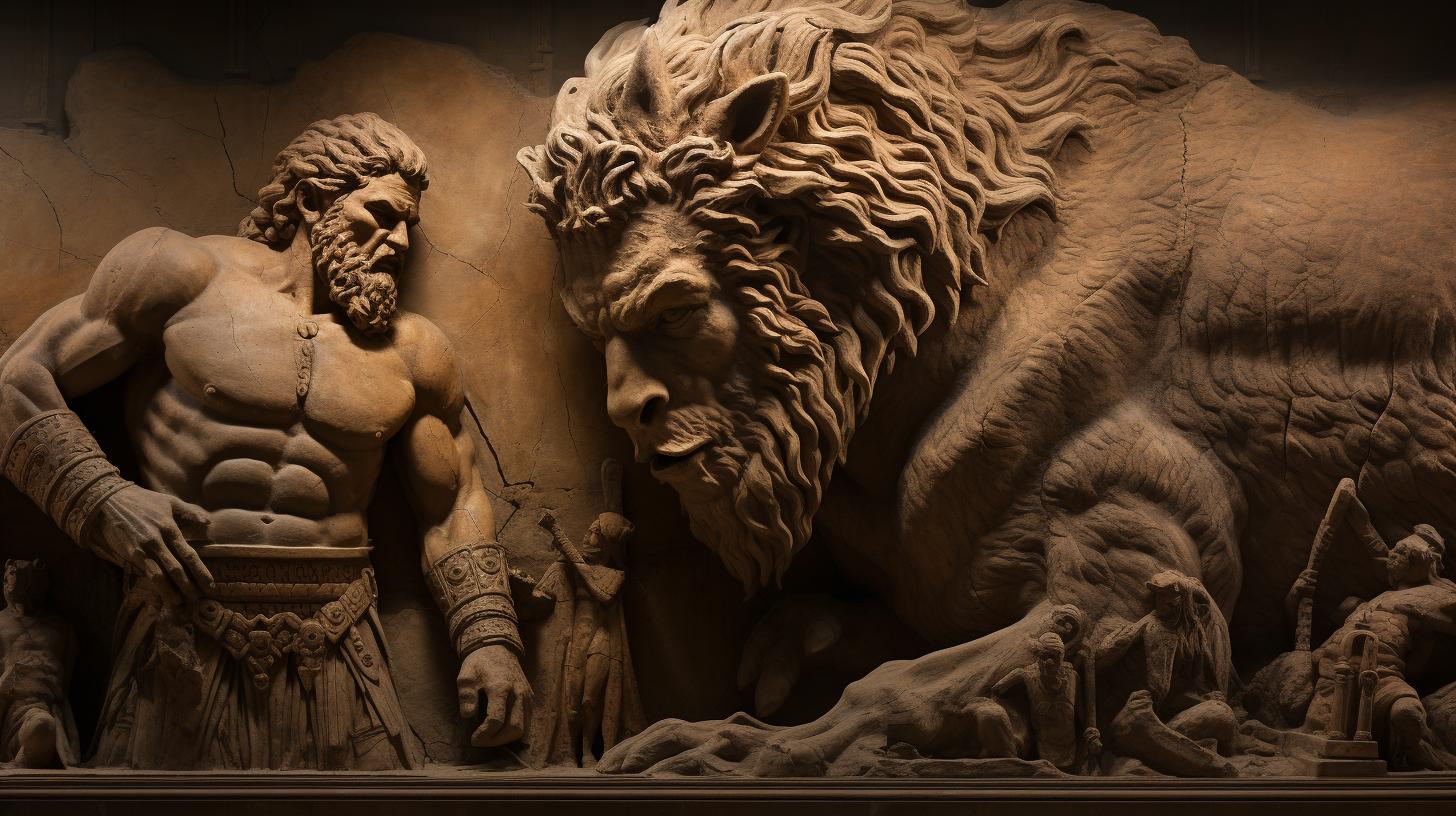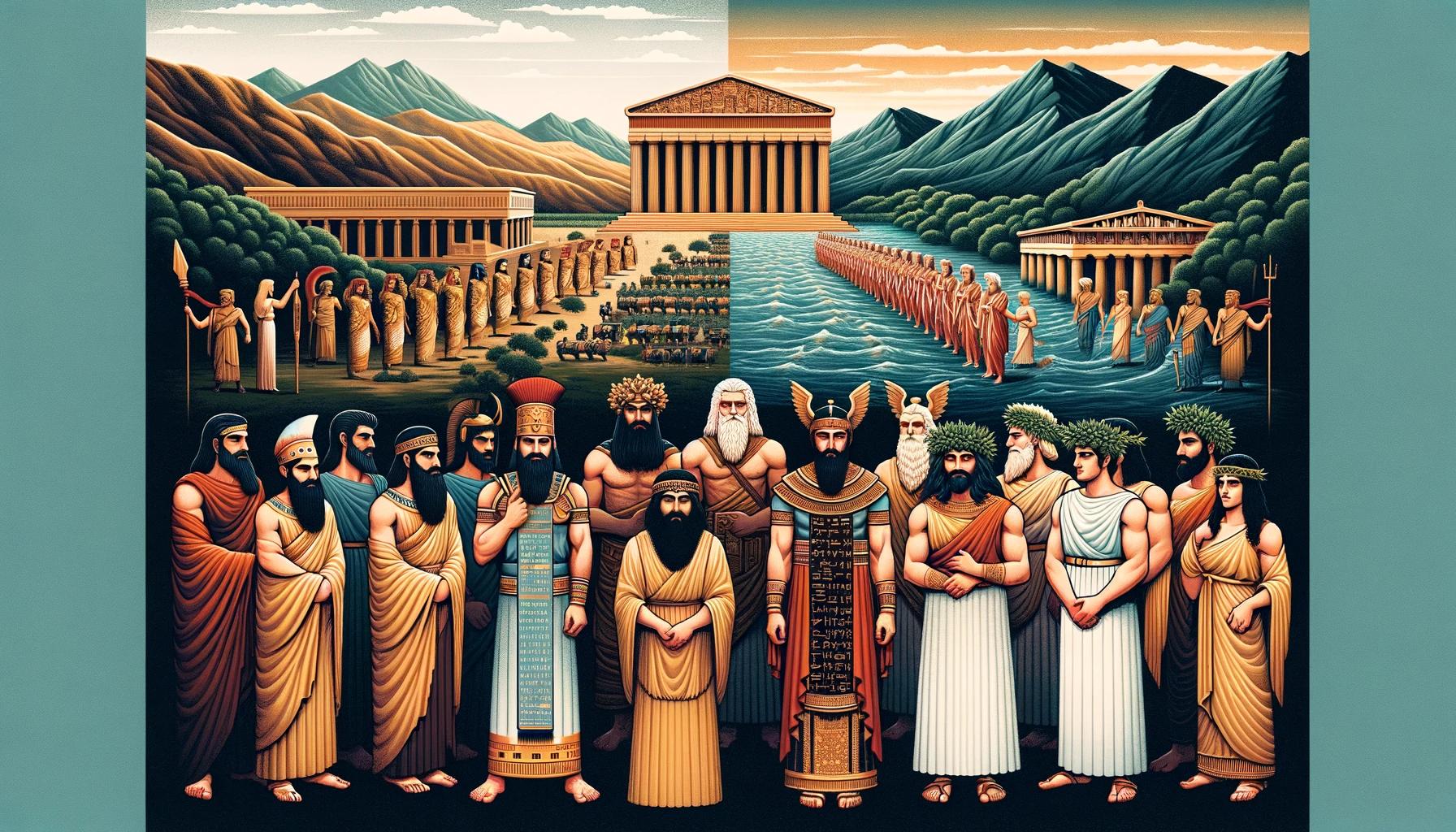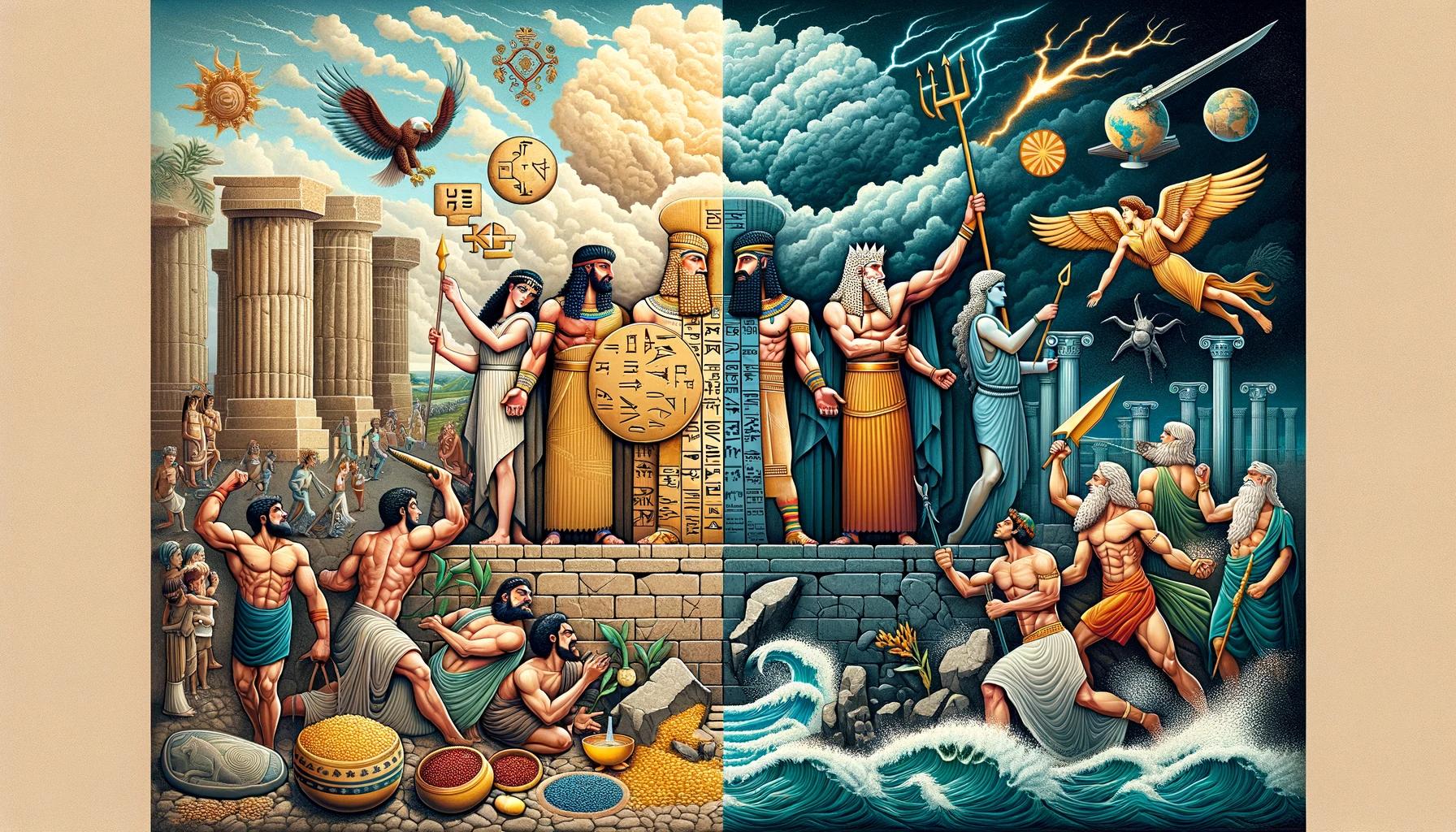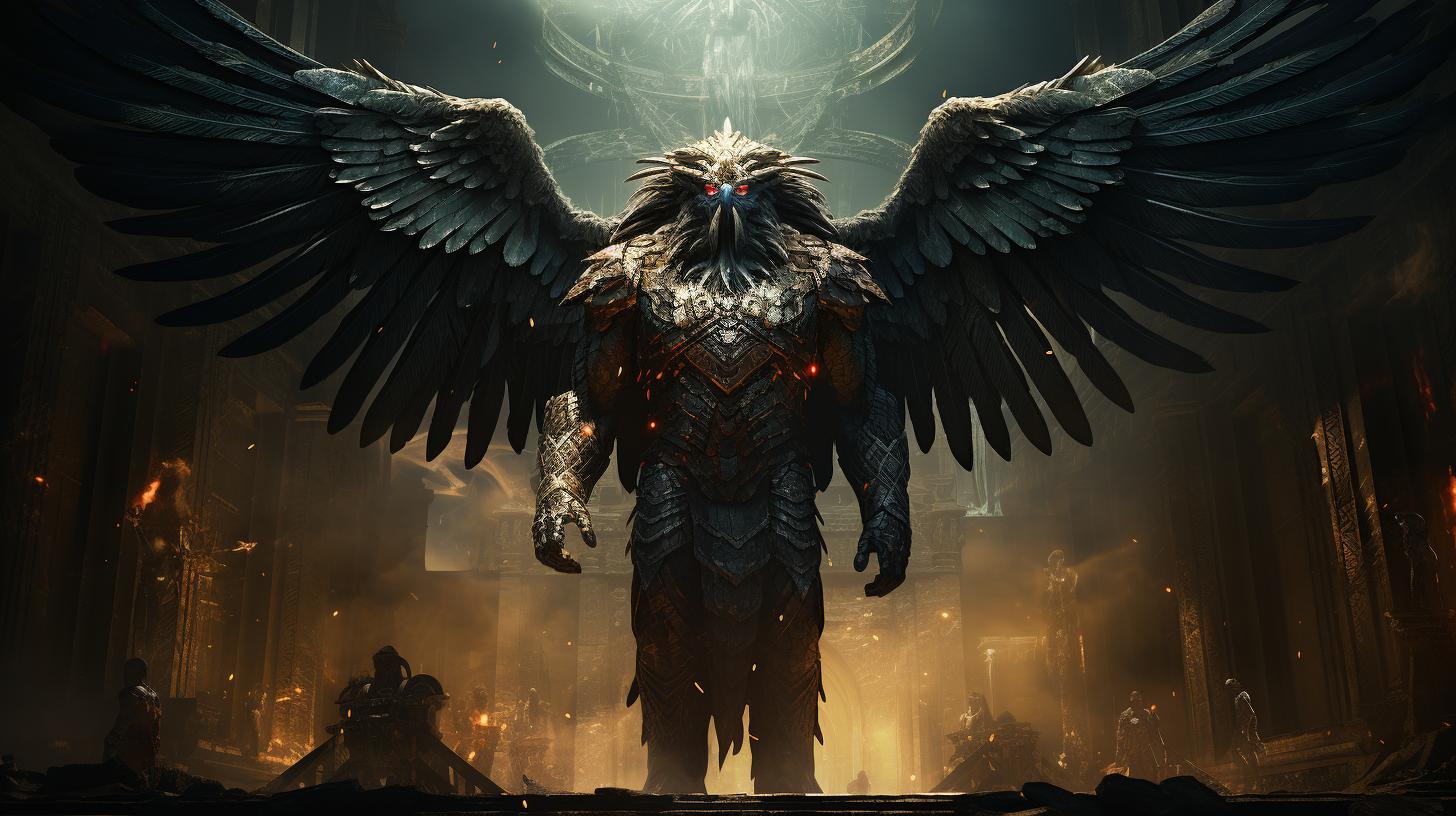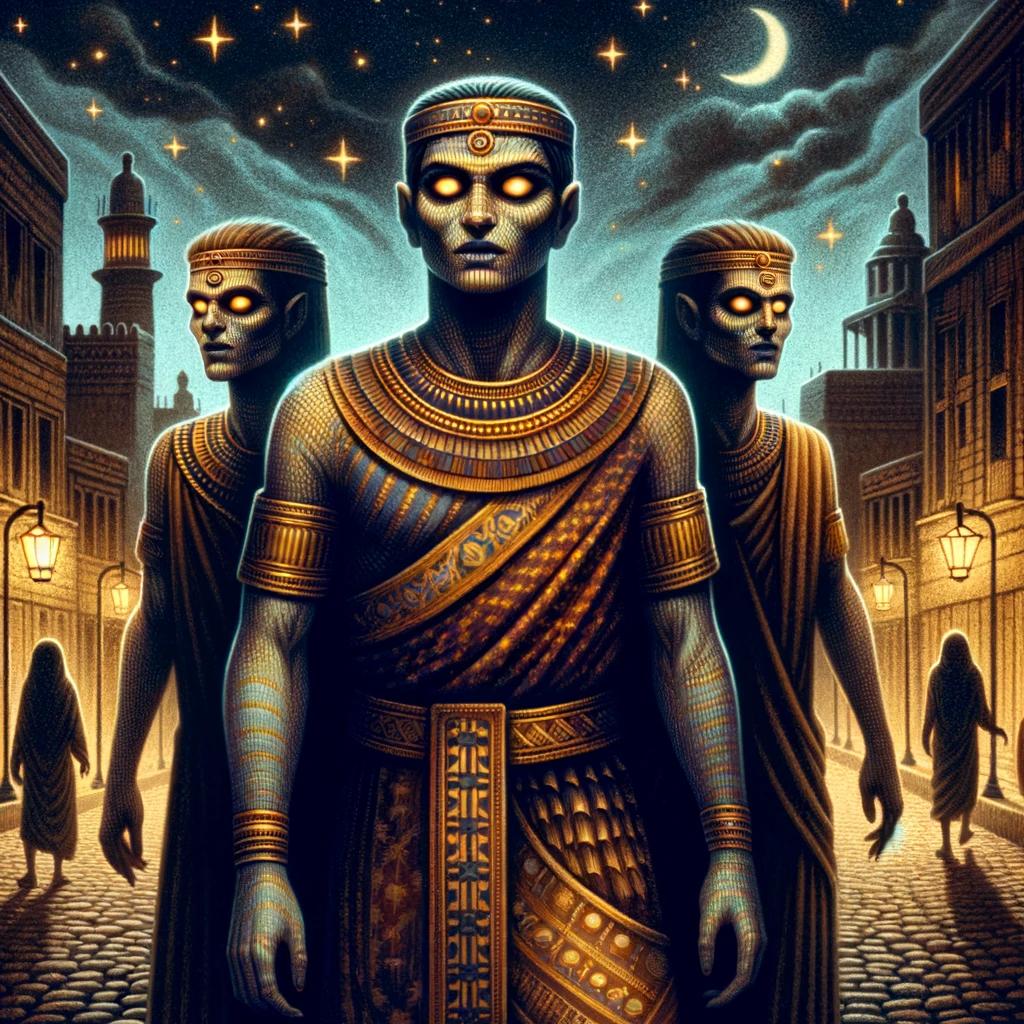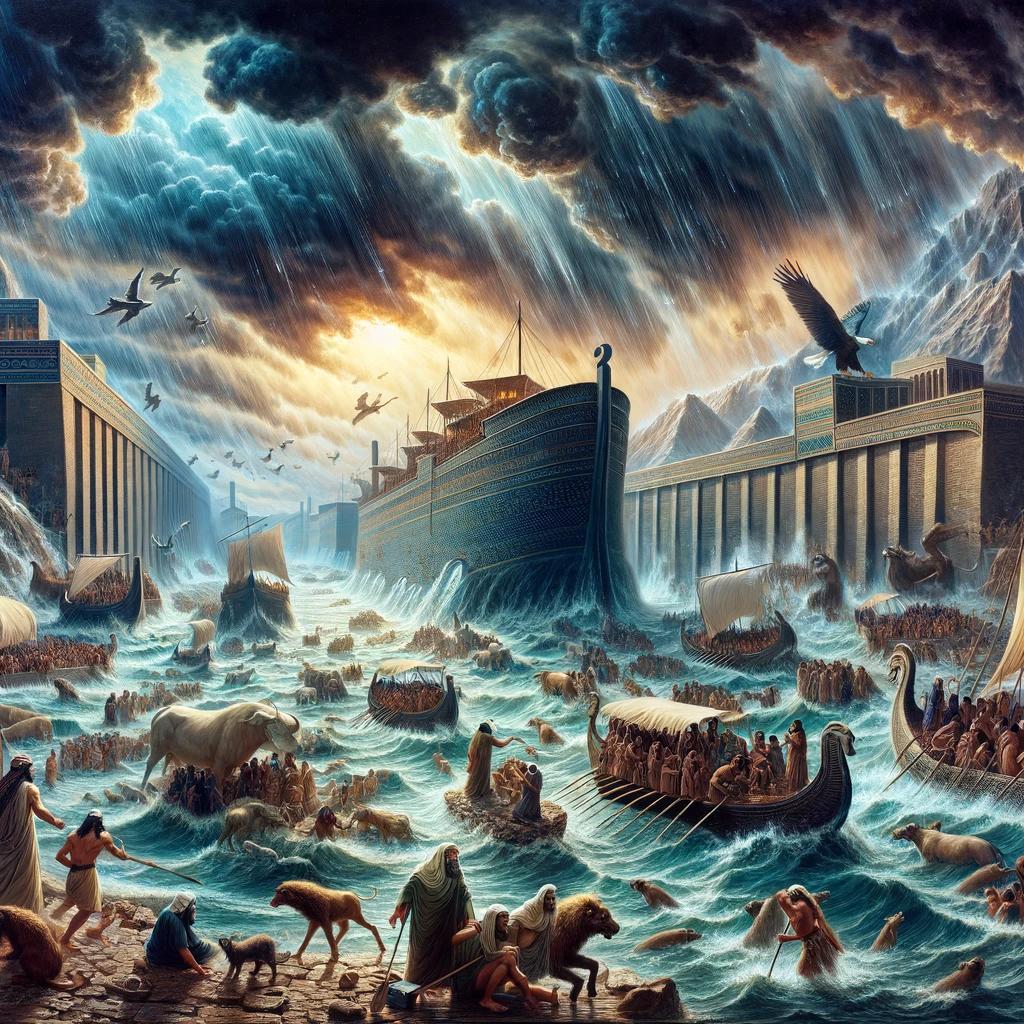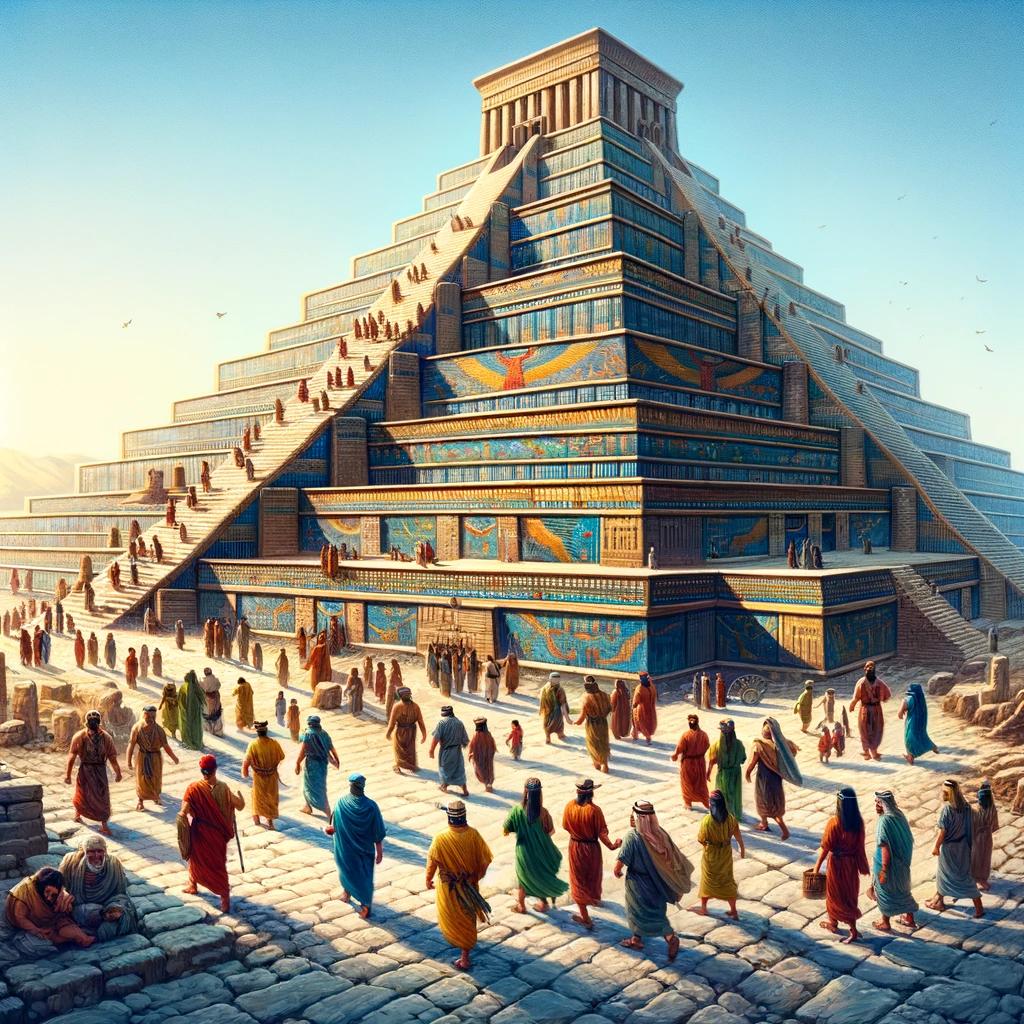Mesopotamian Mythology Creatures: Unveiling the Enigmatic Beings of Ancient Mesopotamia
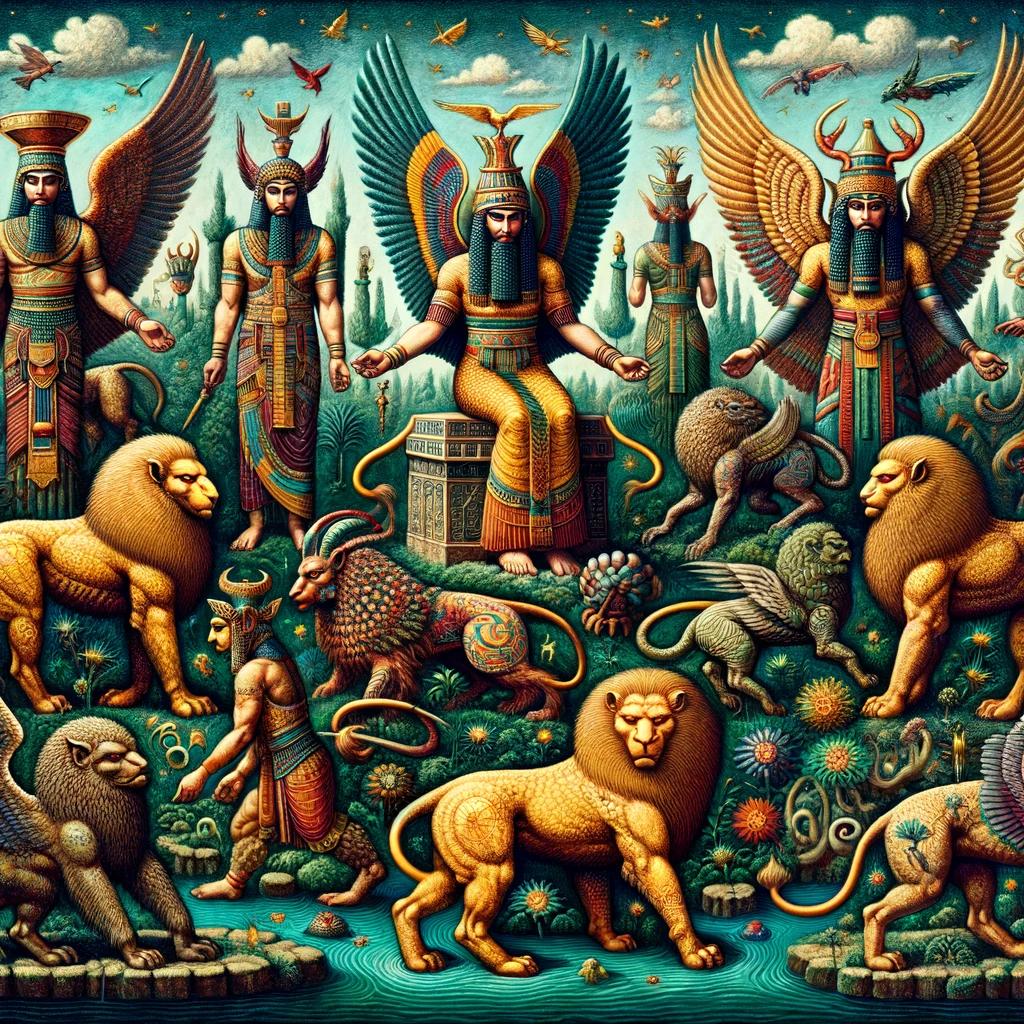
Mesopotamian Mythology Creatures hold a significant place in the ancient beliefs of Mesopotamia. From primordial goddess Tiamat to the majestic Lamassu, these enigmatic beings captivate our imagination.
Discover the Sumerian gods, the mythological tales of Inanna and Marduk, and the intriguing symbolism of the Scorpion Man. Delve into the underworld, explore the power of Mesopotamian deities, and unravel the creation myth.
Join us on a journey through the legacy and influence of Mesopotamian Mythology Creatures in modern culture.
In this article, we’ll explore the fascinating world of Mesopotamian Mythology Creatures and their lasting impact on ancient belief systems and contemporary society.
Mesopotamian Mythology Creatures and Their Significance
The world of Mesopotamian mythology is filled with a diverse range of creatures that hold significant meaning and symbolism. These mythological beings play a crucial role in shaping the ancient beliefs and cultural practices of Mesopotamia, providing insight into the worldview and values of its people.
These creatures are not mere figments of imagination, but rather embodiments of profound concepts and natural phenomena. Each creature carries its own unique significance, representing various aspects of life, nature, and human existence.
From the primordial goddess Tiamat, embodying chaos and creation, to Lamassu, the majestic guardian beings, Mesopotamian Mythology Creatures personify cosmic forces, elemental powers, and spiritual entities that were revered and worshipped by the ancient Mesopotamians.
Exploring the significance of these creatures allows us to delve into the intricate belief systems of the Mesopotamian people, understanding their journey towards self-discovery, their quest for protection and guidance, and their deep connection with the natural world.
By unraveling the symbolism behind these mythological creatures, we can gain a deeper appreciation for the ancient Mesopotamian culture and its enduring impact on human history. Through their stories and roles, Mesopotamian Mythology Creatures provide glimpses into the complexities of human existence, our innate desire to understand the world around us, and the timeless quest for meaning and purpose.
- Tiamat: The Primordial Goddess of Chaos – Explore the origin and significance of Tiamat, the powerful embodiment of chaos and creation.
- Lamassu: The Protective and Majestic Mythological Beings – Discover the role and symbolism of Lamassu, the revered guardian creatures in Mesopotamian mythology.
Through an exploration of these and other Mesopotamian Mythology Creatures, we can unlock the wisdom and insights embedded within these ancient tales, and gain a deeper appreciation for the rich cultural heritage they represent.
Join us on this journey as we unravel the significance and mystique of Mesopotamian Mythology Creatures.
Tiamat: The Primordial Goddess of Chaos
In Mesopotamian Mythology, Tiamat holds a position of great significance as the primordial goddess of chaos. She represents the forces of disorder and turmoil that preceded the creation of the universe.
Tiamat is often portrayed as a fearsome dragon or sea monster, embodying the untameable and destructive power of the watery abyss. Her name itself translates to “the primordial mother” or “the deep.”
According to ancient Mesopotamian myths, Tiamat played a pivotal role in the creation of the cosmos. Prior to the existence of gods and humans, Tiamat was locked in eternal battle with her consort Apsu, the freshwater deity.
Together, they represented the union of saltwater and freshwater. However, their union eventually fell into conflict, with Apsu seeking to destroy the younger generation of deities.
Tiamat, fueled by rage and grief, unleashed her fury upon the gods, creating an army of monstrous creatures to aid in her battle against them.
She spawned an assembly of terrifying beings, including dragons, serpents, scorpion men, and storm demons. Tiamat herself became an embodiment of chaos, a force of destruction seeking to bring down the world order.
In the epic tale known as the Enuma Elish, the great hero Marduk emerges as the champion of the gods and confronts Tiamat. With his power and divine weapons, Marduk defeats the primordial goddess, slaying her and dividing her body to create the earth and the heavens.
This victory marks the establishment of a new cosmic order, with Marduk ascending to become the supreme deity.
Tiamat’s role as the primordial goddess of chaos highlights the Mesopotamians’ understanding of the struggle between order and disorder, creation and destruction.
She symbolizes the raw power of nature and the ever-present possibility of chaos disrupting the harmony of the universe. Tiamat’s story serves as a reminder of the precarious balance maintained by the gods and the constant battle against the forces of chaos.
Sumerian Gods: Exploring the Pantheon of Mesopotamia
Delve into the captivating world of Sumerian gods, an intricate pantheon that holds the essence of Mesopotamian beliefs. The Sumerians revered a diverse array of deities, with each god representing various aspects of life and nature.
At the pinnacle of the Sumerian pantheon stands Anu, the father of all gods, embodying the concept of divine authority and ruling over the heavens. Enlil, the god of air and storms, played a prominent role as the enforcer of cosmic order and the generator of thunderstorms.
Meanwhile, Ea, known as the god of freshwater and wisdom, governed the depths of the oceans and possessed immense knowledge.
The goddess Inanna, the Queen of Heaven and Earth, captivated both mortals and deities alike with her beauty and power.
She symbolized love, fertility, and warfare, and her tales showcased her journey from a young maiden to a wise and powerful goddess.
Other notable Sumerian deities include Nanna, the moon god who influenced the cycles of time and agriculture; Utu, the solar god responsible for bringing light and justice to the world; and Ningal, the goddess of reeds and marshes.
Each god possessed unique attributes and played a specific role within the Sumerian pantheon. Their stories and legends not only shaped the religious beliefs of the ancient Mesopotamians but also reflected the complexities and challenges of human existence.
As you explore the pantheon of Sumerian gods, you’ll discover a tapestry of divine personalities intertwining with mortal lives, forging intricate connections between the earthly and divine realms.
- Anu: The supreme god who rules over the heavens
- Enlil: The god of air and storms, enforcer of cosmic order
- Ea: The god of freshwater and wisdom, possessor of great knowledge
- Inanna: The captivating goddess of love, fertility, and warfare
- Nanna: The moon god who influences time and agriculture
- Utu: The solar god who brings light and justice
- Ningal: The goddess of reeds and marshes
Lamassu: The Protective and Majestic Mythological Beings
The Lamassu, with their imposing presence and enigmatic allure, were revered as protective guardians in the mesmerizing realm of Mesopotamian mythology.
These mythological beings, often depicted as majestic winged bulls or lions with human heads, embodied divine power and offered solace to those who sought their shelter.
Standing tall at the entrances of palaces, temples, and important city gates, the Lamassu served as a constant reminder of the gods’ watchful gaze over the mortal realm.
With their commanding stance and piercing gaze, they deterred evil spirits and malevolent forces from entering sacred spaces. Their sheer size and grandeur instilled a sense of awe and reverence in all who encountered them.
It is believed that the Lamassu possessed the ability to both inspire fear and provide protection. With their celestial wings spread wide, they embodied the divine power of the gods, while their steadfast physiques symbolized strength and stability.
They were considered the embodiment of divine guidance and were venerated as intermediaries between the mortal world and the realm of the gods.
According to ancient Mesopotamian beliefs, the Lamassu acted as celestial guardians, entrusted with the task of safeguarding cities and their inhabitants.
They were believed to possess the ability to detect and ward off malevolent forces, ensuring the harmony and prosperity of the community they watched over.
The Lamassu not only served a practical purpose but also held deep symbolic significance.
As protectors and spiritual envoys, they represented the cosmic order and the divine benevolence bestowed upon humanity. Their presence served as a visual reminder of the gods’ favor and protection, reinforcing the bond between mortals and the divine realm.
The legacy of the Lamassu extends far beyond the ancient Mesopotamian civilization. Their awe-inspiring images have endured the test of time, inspiring artists and architects throughout history. The iconic winged bulls and lions with human heads have found their way into the art and architecture of various cultures, leaving a lasting impact on the visual landscape of our world.
Today, the Lamassu continue to captivate our imagination as we unravel the mysteries of ancient Mesopotamian mythology. Their majestic presence and powerful symbolism remind us of the profound connection between the mortal and divine realms, transcending time and culture.
Mythology of Mesopotamian Gods: Stories and Legends
The mythology of Mesopotamian gods is a captivating tapestry of stories and legends that offer insight into the beliefs and values of ancient civilizations. These tales provide a glimpse into the rich pantheon of deities and their roles in the Mesopotamian cosmology.
- The divine trinity of Anu, Enlil, and Ea stands at the pinnacle of power, representing the heavens, air, and earth respectively. Their complex interplay shapes the destiny of the world and its inhabitants.
- In the epic battle between Tiamat, the primordial goddess of chaos, and Marduk, the champion of the gods, the fate of the cosmos hangs in the balance.
Marduk’s victory establishes his supremacy and lays the foundation for the Mesopotamian pantheon.
- The story of the goddess Inanna highlights her journey to the underworld, where she confronts her sister Ereshkigal. This myth explores themes of death, rebirth, and the cyclical nature of life.
- Gilgamesh, the legendary hero, embarks on a quest for immortality, encountering various mythical creatures and gods along the way.
Through his trials, Gilgamesh grapples with mortality and ultimately learns lessons about the limits of human existence.
- Mesopotamian myths also feature gods with specific spheres of influence. Ninurta, the god of war and agriculture, embarks on mighty quests, while Nergal, the god of the underworld, rules over the realm of the dead and is associated with destruction and pestilence.
These stories and legends serve not only as entertaining narratives but also as vehicles for conveying moral lessons and imparting religious teachings.
They explore fundamental aspects of human existence, such as the nature of divinity, the complexities of the mortal condition, and the significance of cosmic order.
Through the mythology of Mesopotamian gods, we gain a deeper understanding of the ancient Mesopotamian worldview, their fears, hopes, and aspirations.
These tales continue to fascinate and inspire, reminding us of the enduring power of storytelling and the timeless themes that resonate across cultures and generations.
The Enigmatic Scorpion Man: Myth and Symbolism
Among the intriguing creatures found in Mesopotamian mythology is the enigmatic Scorpion Man.
This half-human, half-scorpion being holds a significant place in the ancient belief system of Mesopotamia, showcasing a fusion of human and animal elements.
The Scorpion Man possesses a humanoid upper body, resembling that of a muscular man, but with a fierce, scorpion-like lower body.
This creature symbolizes power, strength, and protection, and is often associated with guarding sacred spaces and important gateways.
In Mesopotamian myth, the Scorpion Man was known to be a loyal servant and guardian of the sun god Shamash. It played a vital role in protecting Shamash’s sacred mountain and the entrance to the divine realm.
The Scorpion Man’s formidable appearance served as a warning to those who might try to trespass into the divine domain or challenge the gods.
The symbolism of the Scorpion Man is multi-faceted.
It represents the duality of nature and the balance between order and chaos. This creature embodies both human intellect and the wild instincts of the scorpion, symbolizing the fusion of wisdom, cunning, and primal power.
Moreover, the Scorpion Man’s association with Shamash, the sun god, connects it with concepts of light, warmth, and divine justice. It signifies the power of the sun to bring illumination and clarity, while also serving as a protector against evil forces and malevolent spirits.
In Mesopotamian art and iconography, the Scorpion Man is often depicted in intricate detail, showcasing its fearsome yet captivating form. These representations can be found in sculptures, reliefs, and cylinder seals, further emphasizing the creature’s significance in the visual culture of ancient Mesopotamia.
The myth and symbolism surrounding the Scorpion Man continue to inspire contemporary artists, writers, and filmmakers. Its enigmatic nature and powerful presence have made it a remarkable figure in popular culture, representing both the strength and the complexity of humanity.
- The Scorpion Man embodies power, strength, and protection.
- It symbolizes the duality of nature and the balance between order and chaos.
- Associated with Shamash, the sun god, it represents light, warmth, and divine justice.
- Depictions of the Scorpion Man in Mesopotamian art highlight its fearsome yet captivating form.
- Its myth and symbolism continue to inspire contemporary artists and filmmakers.
The Ancient Battle Bison Beast and Its Role in Mesopotamian Belief Systems
In the fascinating realm of Mesopotamian mythology, the Ancient Battle Bison Beast occupies a significant place.
This formidable creature was believed to possess immense power and played a unique role in the belief systems of the ancient Mesopotamians.
The Battle Bison Beast, also known as the “Gud-alim,” was revered as a symbol of strength, ferocity, and military prowess.
It was depicted as a massive and aggressive creature, resembling a bison with fearsome horns and a muscular build. Legends often portray the Battle Bison Beast as a formidable opponent, capable of unleashing devastating attacks in the battlefield.
In Mesopotamian mythology, the Battle Bison Beast symbolized the chaos and destructive forces of war. It was associated with the god Nergal, who represented war, pestilence, and strife. The ancient Mesopotamians believed that the Battle Bison Beast would accompany Nergal in battle, bringing destruction and devastation wherever it went.
Furthermore, the Battle Bison Beast played a crucial role in military rituals and ceremonies. Its image adorned the standards and banners of ancient Mesopotamian armies, showcasing their determination and valor on the battlefield.
Warriors sought the protection and guidance of the Battle Bison Beast, believing that its presence would ensure victory and grant them strength and courage.
The significance of the Battle Bison Beast extended beyond the military realm.
It was also associated with abundance and fertility, representing the forces of nature that sustained life in the Mesopotamian agricultural societies. The ancient Mesopotamians believed that by appeasing and honoring the Battle Bison Beast, they could ensure bountiful harvests and prosperity for their communities.
Through its dual symbolism of destruction and fertility, the Battle Bison Beast embodied the complex and interconnected nature of Mesopotamian beliefs. It served as a reminder of the precarious balance between chaos and order, war and peace, and the cyclical nature of life.
The legacy of the Battle Bison Beast can still be seen in Mesopotamian art and artifacts, where its powerful and majestic form is often depicted. The influence of this creature in Mesopotamian belief systems has endured for centuries, leaving an indelible mark on the cultural and religious practices of the ancient Mesopotamians.
The Goddess Inanna: Queen of Heaven and Earth
In the rich tapestry of Mesopotamian mythology, the figure of Inanna shines as a powerful and influential goddess. Known as the Queen of Heaven and Earth, Inanna holds a significant position in the pantheon of Mesopotamian deities.
As a goddess of love, fertility, and war, she personifies both the nurturing and fierce aspects of femininity.
Inanna’s myths and legends depict her as a multifaceted goddess with a complex personality. She is often associated with beauty, sensuality, and desire, captivating the hearts of gods and mortals alike.
Yet, Inanna is not merely a deity of love and passion. She is a goddess of justice and power, capable of divine wrath and leading her followers to victory in battle.
One of the most well-known stories featuring Inanna is her Descent to the Underworld. This myth showcases her courageous journey to the realm of the dead, where she confronts her sister Ereshkigal, the queen of the underworld.
Through this narrative, Inanna represents the cyclical nature of life, death, and rebirth, as well as the power of transformation and resurrection.
In addition to her role as a goddess, Inanna also embodies the concept of the divine feminine in Mesopotamian society. She symbolizes the roles of women as leaders, mothers, and creators.
Inanna’s influence extended beyond religious and mythological realms, as she held a prominent place in daily life and societal structures, inspiring women to assert their power and autonomy.
The significance of Inanna can be seen not only in ancient Mesopotamia but also in the impact she has had on modern culture. Her archetype continues to inspire artists, writers, and scholars, exploring themes of femininity, spirituality, and empowerment.
Inanna’s story serves as a timeless reminder of the strength and complexity of the feminine divine, resonating with individuals seeking a deeper understanding of themselves and the world around them.
Gilgamesh and Enkidu: Epic Heroes in Mesopotamian Mythology
In Mesopotamian Mythology, Gilgamesh and Enkidu are celebrated as epic heroes who embark on extraordinary adventures and demonstrate incredible strength and valor.
The legendary tale of Gilgamesh, the mighty king of Uruk, and Enkidu, a wild man created by the gods, showcases the power of friendship, heroism, and the pursuit of immortality.
Gilgamesh, often described as two-thirds divine and one-third human, ruled over the city of Uruk with an iron fist. Known for his unparalleled strength and beauty, he oppressed his people and disregarded their well-being.
In response to the plea of his subjects, the gods created Enkidu to challenge Gilgamesh’s tyranny and teach him humility.
Enkidu, initially a fearsome and untamed creature, encountered Gilgamesh in a fierce battle, but the two soon recognized each other’s strength and became inseparable companions.
Together, they embarked on numerous adventurous quests, facing formidable monsters and overcoming perilous obstacles.
One of their renowned exploits was their battle against Humbaba, the fearsome guardian of the Cedar Forest.
In an act of bravery, Gilgamesh and Enkidu vanquished Humbaba, showcasing their unmatched heroism and determination.
However, their triumph came with dire consequences. The gods, enraged by their audacity, sentenced Enkidu to death, leaving Gilgamesh grief-stricken and disillusioned.
In his anguish, Gilgamesh embarked on a journey to find eternal life, seeking the counsel of the wise Utnapishtim, the survivor of the Great Flood.
Although Gilgamesh ultimately failed in his quest for immortality, his journey symbolizes the futility of defying divine order and the inevitability of mortality.
Through the tale of Gilgamesh and Enkidu, Mesopotamian mythology explores the themes of friendship, mortality, and the limits of human ambition.
The legacy of Gilgamesh and Enkidu extends beyond ancient Mesopotamian culture.
Their epic story has captivated and influenced literature, art, and popular culture throughout the ages, inspiring countless retellings and adaptations.
Today, the tale of Gilgamesh and Enkidu continues to resonate, reminding us of our shared human experiences, the power of friendship, and the significance of embracing our mortal nature.
Marduk: The Supreme God and His Influence in Mesopotamian Culture
In Mesopotamian Mythology, Marduk holds a position of great significance as the supreme god. He is known as the powerful deity who played a crucial role in the creation of the world and the establishment of order.
Marduk’s rise to prominence can be attributed to his victory over the chaotic and destructive forces personified by the goddess Tiamat. According to the myth, Marduk courageously confronted Tiamat and defeated her, thus bringing balance and order to the universe.
This victory solidified Marduk’s status as the most powerful god, as well as the protector of humanity.
Marduk’s influence extended beyond the realm of mythology and into the fabric of Mesopotamian society.
He embodied qualities such as strength, wisdom, and justice, which were highly esteemed by the ancient Mesopotamians. His role as the supreme god reflected their belief in a well-organized and structured society, where rule and order were paramount.
The Mesopotamians regarded Marduk as the ultimate authority figure, and his worship played a central role in their religious practices. Temples dedicated to Marduk, such as the famous Esagila in Babylon, were important centers of religious and civic life.
The Babylonian New Year festival, known as Akitu, was a grand celebration dedicated to Marduk, during which the king would reaffirm his divine right to rule.
Moreover, Marduk’s influence reached beyond the religious sphere and impacted various aspects of Mesopotamian culture.
His portrayal in art and literature depicted him as a majestic and regal figure, often shown wearing a horned headdress symbolizing his divine authority. The epic tale of Gilgamesh, one of the oldest surviving works of literature, features Marduk as a prominent character, emphasizing his significance in Mesopotamian storytelling.
The legacy of Marduk continued to transcend time, even after the decline of Mesopotamian civilization. His influence can be seen in subsequent belief systems and mythologies, where elements of his character and attributes were assimilated into other deities and figures.
In conclusion, Marduk, the supreme god of Mesopotamian Mythology, played a profound role in shaping the ancient civilization’s understanding of order, justice, and divine power. His remarkable victory over Tiamat and his subsequent influence in Mesopotamian society solidified his status as a revered and influential deity, leaving an indelible mark on their culture and beyond.
The Ancient Mesopotamians’ Beliefs about Giants and Enormous Beings
The ancient Mesopotamians held intriguing beliefs about giants and enormous beings that loomed large in their mythology. These colossal creatures, often depicted with immense strength and intimidating stature, held a prominent place in the cosmology of Mesopotamian culture.
According to Mesopotamian belief, giants were believed to be powerful beings who existed before the creation of the world. These formidable entities were associated with chaos and disorder. They were thought to possess immense physical strength and were often portrayed as semi-divine or legendary figures, capable of wreaking havoc and causing great destruction.
One prominent giant in Mesopotamian mythology is Humbaba, also known as Huwawa. He was a fearsome monster who guarded the Cedar Forest, and it was believed that those who dared to venture into his domain would face imminent danger.
Humbaba was often depicted with a terrifying appearance, towering over humans and exuding an aura of menace and terror.
The belief in giants extended beyond individual figures, as the ancient Mesopotamians also believed in the existence of massive supernatural beings known as “Enormous Beings.”
These beings, as their name suggests, were of colossal size and were associated with chaos and destruction. They were believed to possess an inordinate amount of power and were often depicted as having multiple heads or limbs.
An example of an Enormous Being in Mesopotamian mythology is the Bull of Heaven. This monstrous creature was sent by the gods to punish mankind and bring devastation upon the earth.
With its sheer size and strength, the Bull of Heaven created droughts, famine, and havoc wherever it roamed, leaving destruction in its wake.
These beliefs in giants and enormous beings served as a reflection of the ancient Mesopotamians’ understanding of the forces of nature and the power dynamics within their world.
They symbolized the awe-inspiring and often unpredictable forces that governed their lives, reminding them of the constant struggle between order and chaos.
Through their myths and legends, the ancient Mesopotamians sought to make sense of the world around them, attributing both positive and negative aspects of their existence to these mythological beings.
Giants and enormous beings played a significant role in shaping their worldview and understanding of their place in the universe.
Today, the remnants of these ancient beliefs can still be seen in the art, literature, and popular culture influenced by Mesopotamian mythology.
The captivating tales of giants and enormous beings continue to inspire awe and wonder, reminding us of the ancient Mesopotamians’ rich imagination and their profound connection to the world of the supernatural.
Exploring Creatures and Gods in the Mesopotamian Underworld
The Mesopotamian underworld, a realm shrouded in mystery and darkness, is home to a fascinating array of creatures and gods. Let us embark on a journey to explore this enigmatic realm and discover the mythical beings that inhabit it.
Ereshkigal: Queen of the Underworld
At the heart of the Mesopotamian underworld stands Ereshkigal, the powerful queen of the land of the dead. Often depicted with great authority and wisdom, she governs over the spirits and souls that dwell in this realm.
Galla: The Demonic Messengers
Galla, terrifying and malevolent creatures, serve as messengers and enforcers in the underworld. They roam the domain, carrying out the commands of Ereshkigal and spreading fear among the spirits.
Namtar: The Destined Recorder
Namtar, a servant of Ereshkigal, plays a crucial role in the underworld as the recorder of destinies.
He keeps track of each soul’s fate and ensures that their afterlife is aligned with their deeds in the mortal realm.
Utukku: The Malevolent Spirits
Utukku, known as the Seven Evil Gods, are a group of malevolent spirits that haunt the underworld. They seek to torment and devour wandering souls, representing the darker aspects of the afterlife.
Anunnaki: The Divine Judges
The Anunnaki, a group of deities associated with the underworld, act as judges of the dead. They weigh the souls’ actions in life and determine their eternal fate, whether to ascend to a higher realm or endure perpetual suffering.
The River of the Underworld
Flowing through the underworld is the mysterious river, the crossing point for souls between the realms of the living and the dead. This treacherous river must be navigated by those embarking on their final journey.
Creatures of Darkness
In the depths of the underworld, various creatures of darkness prowl, embodying primal fears and nightmares. These include demonic beings such as Alû and Lilitu, whose presence strikes terror into the hearts of mortals.
Guardians of the Underworld Gates
The gates of the underworld are guarded by fearsome creatures, such as the sphinx-like creatures called lamassu and the horned snakes known as Mušmaḫḫū. These powerful guardians ensure that only the deserving souls enter the realm of the dead.
As we delve deeper into the mesmerizing underworld of Mesopotamian mythology, we encounter a realm of awe-inspiring creatures, dark forces, and divine judges. This exploration sheds light on the intricate beliefs and captivating mythos that influenced ancient Mesopotamia.
Myths and Legends Surrounding Animals in Mesopotamian Culture
The rich mythological tapestry of Mesopotamian culture encompasses not only gods, demons, and hybrid creatures but also a fascinating array of animals steeped in legends and myths. These creatures, revered and feared in equal measure, played significant roles in the beliefs and stories of the ancient Mesopotamians.
Bulls: Bulls held a prominent position in Mesopotamian mythology, symbolizing power, fertility, and abundance. The Bull of Heaven, a formidable celestial beast associated with the goddess Ishtar, brought about drought and famine when unleashed upon the earth.
Lions: Lions, known for their strength and bravery, were tied to the sun god Shamash. Legends spoke of lion-headed deities and mighty guardian lions adorning palace entrances, warding off evil spirits and protecting the inhabitants.
Eagles: Eagles soared high in Mesopotamian mythology, representing divinity, sovereignty, and the divine will. They were associated with the god Anu and often depicted with human heads to symbolize their close connection with humanity.
Serpents: Serpents held both positive and negative connotations in Mesopotamian culture. The horned snake, a hybrid creature with the body of a serpent and the head of a lion or a ram, signified power and protection.
However, the serpent also appeared as an antagonist, tempting humans and bringing chaos as seen in the Epic of Gilgamesh.
Fish: Fish occupied a unique place in Mesopotamian mythology, representing life, fertility, and prosperity.
The half-human, half-fish creature known as the Kulullû (or Apkallu) symbolized wisdom and the imparting of knowledge to humanity.
Dogs: Dogs were revered for their loyalty and protective qualities and were associated with the goddess Bau. In legends, they accompanied the goddess on her journeys through the underworld, guarding her and guiding souls to the afterlife.
- Bulls symbolized power and abundance.
- Lions represented strength and protection.
- Eagles were associated with divinity and sovereignty.
- Serpents held both positive and negative symbolism.
- Fish embodied life, fertility, and prosperity.
- Dogs were revered for their loyalty and protective qualities.
These animals, along with many others, played integral roles in the mythology and cultural beliefs of ancient Mesopotamia.
They added layers of symbolism, offering insights into the connection between the human and divine realms.
The Role of Gods and Their Relationships with Humans in Mesopotamian Mythology
In Mesopotamian mythology, the gods played a central role in the lives of humans. They were believed to have created the world and everything in it, including humans. The gods were seen as powerful beings who controlled various aspects of human existence, such as fertility, agriculture, and war.
The Mesopotamians believed that their relationship with the gods was crucial for their well-being and prosperity. They worshipped the gods through elaborate rituals and offerings, seeking their favor and protection. They built magnificent temples as sacred spaces where they could communicate with the divine and establish a connection between the mortal world and the realm of the gods.
One of the primary roles of the gods in Mesopotamian mythology was to maintain order and balance in the world. They were seen as guardians and protectors, ensuring the harmony of society.
Each god had a specific domain or area of influence, such as Enlil, the god of earth, wind, and air, who was responsible for maintaining the natural order.
Furthermore, the gods served as intermediaries between humans and the divine.
They acted as guides, teachers, and judges, providing wisdom, knowledge, and justice to their human counterparts. Humans could seek guidance and assistance from the gods through prayer, offerings, and even divination rituals.
However, the relationship between gods and humans was not without its challenges. The gods were known for their unpredictable and sometimes capricious nature. They could be swayed by emotions, whims, or personal agendas.
This meant that humans had to navigate a complex dynamic of appeasing the gods, avoiding their wrath, and seeking their favor.
In Mesopotamian mythology, it was believed that humans were created to serve and worship the gods.
Humans had a duty to fulfill their role in society, follow the laws and customs set by the gods, and honor them through devotion and respect. In return, the gods provided protection, blessings, and guidance to ensure the well-being and prosperity of the human community.
The intricate relationship between gods and humans in Mesopotamian mythology reveals the importance of divine intervention and guidance in their worldview. It reflects the belief that humans were dependent on the gods for their survival and success, and that their actions and devotion had a direct impact on their relationship with the divine.
The Creation Myth: Exploring the Origins of the World in Mesopotamian Beliefs
In Mesopotamian beliefs, the Creation Myth holds immense significance as it offers insights into the origins of the world. This ancient myth portrays a complex tapestry of gods, primordial beings, and cosmic battles that ultimately shaped the universe as the Mesopotamians understood it.
The Mesopotamians envisioned the beginning of everything as a primordial chaos, represented by the goddess Tiamat. From Tiamat emerged the divine siblings, including the god Marduk, who would go on to play a crucial role in the creation of the world.
In this myth, Marduk undertakes a great cosmic battle against Tiamat and her monstrous allies, defeating them and establishing order in the universe. From Tiamat’s body, Marduk fashions the Earth and the heavens, positioning the stars, planets, and celestial bodies to their designated places.
The creation myth also narrates the formation of humanity. According to Mesopotamian beliefs, humans were fashioned by the gods from a combination of clay and divine blood to serve as companions and caretakers of the world.
This powerful myth not only provided the Mesopotamians with an explanation for the world’s existence but also reinforced their religious beliefs and practices. It highlighted the divine authority of the gods and their ongoing role in maintaining cosmic order.
Expanding our understanding of the creation myth deepens our appreciation for the complex cosmology of Mesopotamian culture. It sheds light on their perception of the relationship between gods, humans, and the natural world.
The creation myth also reveals their belief in the divine power that shapes and sustains existence.
The legacy of the creation myth can be seen in various aspects of Mesopotamian society, such as religious rituals, architectural designs, and artistic representations.
It influenced the worldview of the people, impacting their understanding of the divine and their place in the cosmic order.
Exploring the creation myth allows us to immerse ourselves in the rich tapestry of Mesopotamian mythology.
It unveils the origins of the world as understood by this ancient civilization, offering a fascinating glimpse into their cosmogony and the significance they attributed to the gods and their divine acts of creation.
The Gods and Goddesses Associated with Nature and the Elements
In Mesopotamian mythology, the gods and goddesses are closely connected with nature and the elements. These divine beings were believed to have control and influence over various aspects of the natural world, making them vital figures in the ancient Mesopotamian belief system.
One of the prominent deities associated with nature is Enlil, the god of the air and storms. He was believed to control the powerful winds and was often depicted as a bearded man with a crown symbolizing his authority.
Enlil’s role in maintaining and controlling the atmosphere showcased his influence over the natural elements.
- Enlil: God of the air and storms
- Enki: God of water and wisdom
- Ninurta: God of agriculture and the plow
- Shamash: God of the sun and justice
- Ninmah: Goddess of fertility and motherhood
Another significant deity associated with nature is Enki, the god of water and wisdom.
Enki was often depicted as a bearded man holding a water vessel, representing his control over the waters that sustained life. He was believed to provide knowledge and insight, making him a significant figure in both the natural and intellectual realms.
Ninurta, the god of agriculture and the plow, was revered for his role in promoting fertile lands and bountiful harvests. He symbolized the agricultural cycles and the importance of cultivation for sustaining civilization.
Ninurta was often depicted with a spear in one hand and a plow in the other, emphasizing his connection to nature and the essential role of agriculture.
Shamash, the god of the sun and justice, held a vital position in Mesopotamian mythology.
As the sun god, he provided light and warmth to the world, ensuring the growth of crops and the progression of life. Additionally, Shamash was associated with justice and truth, representing the balancing and harmonizing forces in the natural order.
Ninmah, the goddess of fertility and motherhood, embodied the power of creation and the nurturing aspects of nature. She was believed to oversee the growth and development of all living beings, both humans and animals.
Ninmah’s association with fertility emphasized the importance of reproduction and continuance of life in the natural world.
These gods and goddesses associated with nature and the elements played integral roles in Mesopotamian mythology, reflecting the profound connection between ancient societies and the natural world around them.
Their influence and symbolism in the cultural and religious practices of Mesopotamia further demonstrates the significance of nature in shaping ancient beliefs and traditions.
Exploring the Power and Influence of Mesopotamian Deities
The deities of Mesopotamian mythology held immense power and exerted a significant influence over the ancient civilization.
These gods and goddesses were believed to control various aspects of life, nature, and human affairs.
Diverse Array of Deities
The Mesopotamian pantheon consisted of numerous gods and goddesses, each with their own domain and sphere of influence. From Enlil, the god of wind and storms, to Shamash, the sun god who governed justice, Mesopotamian deities embodied a range of powers and attributes.
Divine Intervention in Human Life
Mesopotamians believed that the gods actively intervened in human affairs. They were invoked for protection, guidance, and assistance. Rituals, sacrifices, and offerings were dedicated to these deities to seek their favor and blessings.
Symbols of Authority and Power
Mesopotamian deities were often depicted with symbols that represented their authority and power. Enlil held the tablet and stylus denoting his role as the divine scribe, while Ishtar, the goddess of love and war, adorned herself with a lion-headed staff to showcase her dominion over the animal kingdom.
Interplay of Polytheism and Cosmic Order
The divine hierarchy and relationships among Mesopotamian deities reflected the cosmic order. Enki, the god of wisdom and creation, played a pivotal role as the mediator between gods and humans, maintaining balance and harmony in the universe.
Legacy in Art and Architecture
Mesopotamian deities influenced the art and architecture of the civilization. Temples were built in their honor, adorned with intricate reliefs depicting their divine powers and qualities. The ziggurats, monumental stepped structures, served as sacred sanctuaries dedicated to their worship.
Influence on Modern Culture
The influence of Mesopotamian deities can still be seen in modern culture. Their stories and legends continue to inspire literature, art, and entertainment. The enduring legacy of Mesopotamian mythology provides a glimpse into the ancient belief system and its impact on the human imagination.
An Exploration of the Divine and Human Interactions in Mesopotamian Myths
Within the rich tapestry of Mesopotamian mythology, the interactions between divinities and humankind form a captivating aspect of the ancient belief system. Mesopotamian myths highlight the intricate connection between gods, goddesses, and mortals, reflecting the intricate web of relationships, power dynamics, and divine intervention within the cosmic order.
In Mesopotamian myths, gods often played an active role in human affairs, demonstrating their authority and influence over various aspects of life. They could act as patrons, offering protection, guidance, and blessings to favored individuals or cities.
In return, humans expressed their devotion and offered prayers, sacrifices, and rituals to maintain a harmonious relationship with the divine.
At times, these interactions revealed the complex nature of human-divine relationships, where gods and goddesses displayed both benevolence and wrath.
While they could bring prosperity, health, and victory, they also possessed the power to inflict punishment, disease, and destruction upon those who defied or displeased them. The myths depict humankind’s acknowledgment of their dependency on divine forces and the need for appeasement and obedience to ensure their well-being.
Moreover, tales of divine and human interactions often highlighted the challenges, trials, and moral dilemmas faced by mortals in their encounters with the divine. Heroes like Gilgamesh and Enkidu embarked on epic quests, encountering gods and goddesses who tested their resolve, granted them wisdom, or presented obstacles to overcome.
These narratives conveyed timeless lessons about mortality, the pursuit of knowledge, and the intricacies of human nature.
The divine and human interactions in Mesopotamian myths also revealed the power of agency and free will, emphasizing the importance of human decision-making and responsibility.
Mortals found themselves at crossroads, needing to make choices and face the consequences, despite the influence of divine intervention and destiny. These tales reflected the nuanced understanding of humans as active participants in shaping their own fate, while acknowledging the overarching influence of the gods.
Furthermore, the myths depicted instances of divine-human partnerships, where individuals were elevated to divine status, such as the goddess Inanna’s union with Dumuzid. These unions brought forth tales of love, sacrifice, and the intricate balance between mortal and divine realms.
In summary, the exploration of divine and human interactions in Mesopotamian myths unravels a multifaceted tapestry of relationships, power dynamics, and moral dilemmas. These captivating narratives serve as windows into ancient Mesopotamian beliefs, reflecting the intricate interplay between gods, goddesses, and mortals within the cosmic framework.
They reveal the human yearning for guidance, protection, and meaning in life, while acknowledging the complex nature of their relationship with the divine.
Symbolism and Iconography in Mesopotamian Mythology Creatures
The symbolism and iconography present in Mesopotamian Mythology Creatures play a crucial role in understanding their significance and cultural context. The ancient Mesopotamians used various symbols and artistic representations to convey deeper meanings and convey their beliefs.
Iconography, in particular, was an essential aspect of Mesopotamian art, serving as a visual language to communicate myths, religious concepts, and narratives. Through intricate carvings, sculptures, and wall reliefs, the Mesopotamians depicted the characteristics and attributes of mythological creatures.
One recurring symbol in Mesopotamian mythology is the serpent, often associated with wisdom, knowledge, and fertility. This symbol can be seen in depictions of gods, as well as hybrid creatures like the Scorpion Man and the Horned Snake.
Additionally, the Bull of Heaven represents power, fertility, and strength. Depicted as a celestial creature, this bull is often associated with drought and famine, symbolizing the devastating consequences of its presence.
Another prominent symbol is the combination of human and animal characteristics in hybrid creatures like the Lamassu. These mythical beings, with the body of a bull or lion, wings of an eagle, and the head of a human, represent protection and guardianship.
Furthermore, the use of specific colors in art played a significant role in symbolizing different attributes of the mythological creatures. For example, the color blue was often associated with water and divine power, while red represented war and aggression.
The Mesopotamians also used celestial symbols, such as stars and planets, to represent the divine and the heavens. These symbols were incorporated into depictions of gods and celestial creatures, emphasizing their connection to the spiritual realm.
- Symbolism and iconography in Mesopotamian Mythology Creatures played a significant role in conveying deeper meanings and cultural beliefs.
- Iconography served as a visual language to communicate myths, religious concepts, and narratives.
- The serpent symbolized wisdom, knowledge, and fertility in Mesopotamian mythology.
- The Bull of Heaven represented power, strength, and the consequences of its presence.
- Hybrid creatures like the Lamassu combined human and animal characteristics to symbolize protection and guardianship.
- Color symbolism, such as blue for water and red for war, added further depth to artistic representations.
- Celestial symbols like stars and planets emphasized the divine nature of mythological creatures.
In conclusion, symbolism and iconography in Mesopotamian Mythology Creatures played a vital role in conveying cultural beliefs and conveying deeper meanings associated with these creatures.
Through intricate artistic representations, symbols such as serpents, celestial bodies, and hybrid creatures conveyed wisdom, power, protection, and the intricate relationship between the divine and mortal realms.
The Legacy and Influence of Mesopotamian Mythology Creatures in Modern Culture.
The rich mythological creatures of ancient Mesopotamia continue to captivate and inspire modern culture in various forms. From novels and movies to video games and artwork, their influence can be seen in a wide range of creative expressions.
Here are some key aspects of how Mesopotamian mythology creatures have left their mark:
- Literature: Authors have drawn inspiration from Mesopotamian mythology creatures to create compelling narratives that explore themes of power, struggle, and the supernatural.
These creatures and their stories add depth and complexity to fictional worlds and engage readers in captivating tales.
- Film and Television: The allure and mystique of Mesopotamian mythology creatures have been brought to life on the big screen and television.
They provide unique and visually striking characters that contribute to the overall cinematic experience and transport viewers to ancient realms.
- Video Games: Game developers have incorporated Mesopotamian mythology creatures into interactive worlds, allowing players to encounter and confront these legendary beings firsthand.
This immersion in the mythological lore deepens the gaming experience and provides a sense of awe and wonder.
- Art and Sculpture: Artists have been inspired by the intricate depictions of Mesopotamian mythology creatures found in ancient artifacts.
Their imaginative interpretations and reinterpretations breath new life into these creatures, showcasing their timeless appeal and symbolism.
- Symbolism and Design: Mesopotamian mythology creatures have become iconic symbols in popular culture.
Their presence can be seen in jewelry, clothing, tattoos, and other forms of personal adornment, representing a connection to ancient traditions and a fascination with the mysterious.
The enduring legacy of Mesopotamian mythology creatures in modern culture speaks to the timeless fascination humans have with the supernatural and the power of storytelling.
These captivating beings continue to inspire and ignite our imagination, reminding us of the rich tapestry of human beliefs and the enduring impact they can have on our collective consciousness.
.











